2011
1. Liang, Fuxin; Shen, Ke; Qu, Xiaozhong; Zhang, Chengliang; Wang, Qian; Li, Jiaoli; Liu, Jiguang; Yang, Zhenzhong*. Inorganic Janus Nanosheets, Angew. Chem. Int. Ed., 2011, 50(10): 2379-2382.
Another face to Janus particles: Silica Janus nanosheets were synthesized by crushing Janus hollow spheres formed by self-assembled materialization of an amphiphilic emulsion interface. The Janus nanosheets serve as solid surfactants and can be used collecting oil or hazardous chemical spills.

DOI: 10.1002/anie.201007519
https://doi.org/10.1002/anie.201007519
2. Liang, Fuxin; Liu, Jiguang; Zhang, Chengliang; Qu, Xiaozhong; Li, Jiaoli; Yang, Zhenzhong*. Janus Hollow Spheres by Emulsion Interfacial Self-Assembled Sol-Gel Process, Chem. Commun., 2011, 47(4): 1231-1233.
Janus hollow silica spheres with an asymmetric shell are synthesized by self-assembled sol–gel process at an emulsion interface, and desired materials can be preferentially laden inside the cavities from their surroundings.

DOI: 10.1039/c0cc03599h
https://doi.org/10.1039/c0cc03599h
3. Ni, Wei; Liang, Fuxin*; Liu, Jiguang; Qu, Xiaozhong; Zhang, Chengliang; Li, Jiaoli; Wang, Qian; Yang, Zhenzhong*. Polymer Nanotubes toward Gelating Organic Chemicals, Chem. Commun., 2011, 47(16), 4727-4729.
Crosslinked polymer nanotubes are large scale synthesized. The method is based on fast cationic polymerization using immiscible initiator nanodroplets. Nanoporous network processed from the nanotubes is superhydrophobic, which can absorb all the tested organic chemicals forming robust gels. The nanotubes are promising in the collection of spilled organic chemicals, detoxification and water treatment.
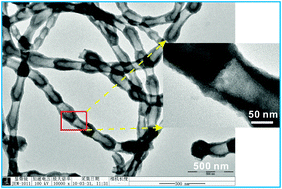
DOI: 10.1039/c1cc10900f
https://doi.org/10.1039/C1CC10900F
4. Meng, Zhaokai; Wang, Qian*; Qu, Xiaozhong; Zhang, Chengliang; Li, Jiaoli; Liu, Jiguang; Yang, Zhenzhong*. Papillae Mimetic Hairy Composite Spheres towards Lotus Leaf Effect Coatings, Polymer, 2011, 52(3): 597-601.
An effective approach is proposed to fabricate a robust superhydrophobic coating constructed from hairy composite spheres. The hairy spheres mimic structure of the papillae on the surface of lotus leaf. The synthesis is based on template method and the corresponding PANi hairy spheres are prepared by polymerization induced diffusion growth via nanosized channels of a polymer cage. The composite spheres become more robust by coating a layer of inorganic materials onto the PANi hairy spheres. By using a middle adhesive layer of epoxy resin, the hairy spheres can be tightly attached to the substrate. The superhydrophobic coating is achieved with a contact angle of 159.9 ± 1.9° and tilt angle below 2° by a post hydrophobic modification with octadecyltrichlorosilane. Such coating is robust enough to resist water flushing and organic solvents. This method can be scaled up for almost all kinds of substrates.

DOI: 10.1016/j.polymer.2010.12.020
https://doi.org/10.1016/j.polymer.2010.12.020
5. Zhao, Lingling; Zhu, Lijun; Liu, Fuyong; Liu, Chenyang; Shan-Dan*; Wang, Qian; Zhang, Chengliang; Li, Jiaoli; Liu, Jiguang; Qu, Xiaozhong*; Yang, Zhenzhong*. PH Triggered Injectable Amphiphilic Hydrogel Containing Doxorubicin and Paclitaxel, Int. J. Pharm., 2011, 410(1-2): 83-91.
Injectable hydrogel with hydrophobic microdomains for incorporating both hydrophilic and hydrophobic drugs, herein doxorubicin hydrochloride (DOX) and paclitaxel (PTX), was synthesized through dynamic bonding of glycol chitosan and benzaldehyde capped poly(ethylene glycol)-block-poly(propylene glycol)-block-poly(ethylene glycol) via Schiff's reaction triggered by environmental pH. Rheology tests show that the inclusion of hydrophilic drug decreases the gelation time and gains more robust gel, while the addition of hydrophobic drug has opposite influences. Dual-drug release from the DOX + PTX loaded gels was observed and the release rate can be accelerated by decreasing the environmental pH from physiological (7.4) to weak acidic pH (6.8). In vivo investigation proved that the gels were able to diminish the amount of DOX in blood circulation and limit the DOX-induced cardiotoxicity. By intratumoral administration, the hydrogel-drug formulations resulted in efficient growth inhibition of subcutaneous tumor (B16F10) on C57LB/6 mouse model. The advantage of the current system for DOX + PTX combination therapy was demonstrated by a prolongation of survival time in comparison with the single drug therapy.

DOI: 10.1016/j.ijpharm.2011.03.034
https://doi.org/10.1016/j.ijpharm.2011.03.034
6. Wang, Yanhong; Zhang, Chengliang*; Tang, Chen; Li, Jing; Shen, Ke; Liu, Jiguang; Qu, Xiaozhong; Li, Jiaoli; Wang, Qian; Yang, Zhenzhong*. Emulsion Interfacial Synthesis of Asymmetric Janus Particles, Macromolecule, 2011, 44(10): 3787-3794.
We have proposed a simple method to synthesize asymmetric Janus polymer particles at an emulsion interface. Morphological evolution of the particles with polymerization and their dependence on some key variables reveal that both cross-linking degree of the particles and interfacial tension difference play key roles in achieving the asymmetric shapes. By selective growth of functional materials onto the desired sides, composition and microstructure of the Janus particles can be controlled. The representative PS/PAM Janus particles are amphiphilic and can be used as solid surfactants to stabilize emulsions, which preferentially orientate at the interface.

DOI: 10.1021/ma102945t
http://pubs.acs.org/doi/abs/10.1021/ma102945t
7. Zhao, Lingling; Zhu, Lijun; Wang, Qian; Li Jiaoli; Zhang, Chengliang; Liu, Jiguang; Qu, Xiaozhong*; He, Guanglong; Lu, Yunfeng; Yang, Zhenzhong*. Synthesis of Composite Microgel Capsules by Ultrasonic Spray Combined with In Situ Crosslinking, Soft Matter, 2011, 7(13): 6144-6150.
Composite microgel capsules were fabricated through an ultrasonic spray accompanied by in situ surface crosslinking between glycol chitosan (GC) and benzaldehyde capped poly(ethylene glycol) (OHC–PEG–CHO) in the nebulized droplets. The methodology enables a selective one-pot encapsulation for different functional species inside the interior cavity or within the shell. Herein lithium phthalocyanine (LiPc) microcrystals and citrate stabilized iron oxide (Fe3O4) nanoparticles were selected as model materials for the functionalization, which led to the electron paramagnetic resonance (EPR) and superparamagnetic dual performance of the composite microgel capsules. This shows the potential of the microgel capsules in diagnosis and targeting delivery applications.
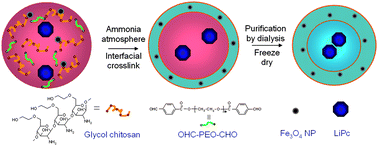
DOI: 10.1039/c1sm05305a
http://pubs.rsc.org/en/Content/ArticleLanding/2011/SM/c1sm05305a#!divAbstract
8. Shen, Ke; Liang Fuxin*; Liu, Jiguang; Qu, Xiaozhong; Zhang, Chengliang; Li, Jiaoli; Wang, Qian; Wei, Wei; Lu, Yunfeng; Yang, Zhenzhong*. Inward Template Synthesis of Intact Hollow Spheres, Polymer, 2011, 52(20): 4418-4422.
A facile and general one-step approach is presented to synthesize hollow spheres with varied composition by an aerosol-assisted solvent evaporation process. The monomer of ethyl-2-cyanoacrylatemide contained in the aerosol droplets can form an outer shell by a fast polymerization around the droplets. Materials inside the droplets further grow inwardly against onto the interior surface of the first shell forming another shell forming composite hollow spheres. The hollow spheres are derived by dissolution of the outer shell, therefore the intact shell can be well preserved. Many approaches can be exploited forming the second shell for example sol-gel process of oligomers and phase separation from polymer solutions. Microstructure of the hollow spheres can be tuned from smooth to porous. The methodology is general.

DOI: 10.1016/j.polymer.2011.07.036
https://doi.org/10.1016/j.polymer.2011.07.036
9. 屈小中, 杨振忠*, “苯甲酰亚胺动态化学键在构筑pH响应药物载体中的应用”, 高分子学报, 2011, 10: 1118-1124.
介绍了作者近期利用苯甲酰亚胺化学结构构筑对生理环境pH值响应的药物输送体系的工作进展。亚胺(Schiff碱)作为动态共价键早已为人们所熟知,但其在pH敏感药物输送载体领域的应用并不多。苯甲酰亚胺由于苯环与碳氮双键共轭作用使其在生理pH值下的稳定性更好,同时具有在弱酸环境下(如固态肿瘤细胞外环境、内涵体环境等)的水解特性,适合作为pH响应性单元构筑药物控制释放载体,如聚合物胶束、纳米颗粒等。此外,利用Schiff碱反应随pH值改变的可逆性还可制备可注射凝胶等药物输送体系。
DOI: 10.3724/SP.J.1105.2011.1118
http://www.gfzxb.org/thesisDetails#10.3724/SP.J.1105.2011.11181&lang=zh
10. 张成亮, 杨振忠*, “高分子复合材料微加工”, 高分子通报, 2011, 10: 50-62.
高分子纳米复合是深入理解高分子链结构和宏观性能的关键,直接影响着复合材料向尺寸微小化、控制精细化、复合功能化和系统集成化方向发展的进程,涉及了高分子复合材料微加工中的诸多问题,其中多组分多尺度空间分布和形态精细控制的物理与化学是两个关键科学问题。自2000年起,我们围绕这两个关键问题展开系列研究,主要面向复杂性复合颗粒和纳米孔复合膜两种典型形态结构,发展了模板合成微加工方法,实现对宏观形态的有效控制,并且通过软物质(高分子凝胶和嵌段共聚物)特殊作用诱导组分定位生长控制微结构,系统研究其物理与化学问题,发展了多组分多尺度空间分布高效精确调控的方法,同时实现了组分的空间分布和形态控制。
DOI:10.14028/j.cnki.1003-3726.2011.10.018
https://doi.org/10.14028/j.cnki.1003-3726.2011.10.018
2012
1. Liu, Bao; Liu, Jiguang; Liang, Fuxin; Wang, Qian; Zhang, Chengliang; Qu, Xiaozhong; Li, Jiaoli; Qiu, Dong Qiu; Yang, Zhenzhong*. Robust Anisotropic Composite Particles with Tunable Janus Balance, Macromolecules, 2012, 45(12): 5176-5184.
We report a general emulsion approach to protrude a lobe by swelling the polymer core from a core–shell structure, achieving anisotropic Janus composite particles with tunable chemistry, shape, size, and size ratio of the two parts thus Janus balance. Oil-in-water emulsion is employed to swell a polymer core through the crack open hole within the shell, and the core protrusion is restricted in the particle/oil confined compartments enveloped with surfactant. When monomers are used as the oil solvents, cross-linking can strengthen the polymer lobe to tolerate against organic solvents. By tuning polymerization time and monomer/particle weight ratio, the size ratio of the polymer/inorganic parts thus Janus balance of the composite particles is continuously tunable across from more hydrophilic to more lipophilic. The robust anisotropic particles with tunable Janus balance can be further used as solid surfactants to tune microstructure of emulsions.

DOI: 10.1021/ma300409r
http://pubs.acs.org/doi/abs/10.1021/ma300409r
2. Zhu, Lijun Zhu; Zhao, Lingling; Qu, Xiaozhong*; Yang, Zhenzhong*. pH-Sensitive Polymeric Vesicles from Coassembly of Amphiphilic Cholate Grafted Poly(L-lysine) and Acid-Ceavable Polymer-Drug Conjugate, Langmuir, 2012, 28(33): 11988-11996.
Herein we report a coassembly method toward the preparation of pH-sensitive polymeric vesicular aggregates, using comb-shaped amphiphilic polymers, i.e., cholate grafted poly(l-lysine) (PLL-CA), with an amphiphilic poly(ethylene glycol)–doxorubicin conjugate (PEG-DOX). Because the drug conjugate includes a low-pH labile bond, i.e., benzoic imine, the permeability of the coassembled polymeric vesicles can be tuned by changing either the PLL-CA/PEG-DOX weight ratio or the environmental pH from 7.4 to 6.5. Furthermore, at lower pH values such as 5.0, the vesicles destabilize. The pH sensitivity leads to enhanced uptake of the vesicles by cancer cells (MCF-7) under a condition close to the extracellular environment of solid tumor (pH = 6.5) and subsequent efficient endosome escape after the endocytosis.

DOI: 10.1021/la3015767
http://pubs.acs.org/doi/abs/10.1021/la3015767
3. Jin, Haiqiang; Tan, Hui; Zhao, Lingling, Sun, Weiping; Zhu, Lijun; Sun, Yongan; Hao, Hongjun; Xing, Haiying; Liu, Linlin; Qu, Xiaozhong*; Huang, Yining*; Yang, Zhenzhong*. Ultrasound-Triggered Thrombolysis Using Urokinase-Loaded Nanogels, Int J Pharm., 2012, 434(1-2): 384-390.
To find a way to modulate the effect of thrombolytic proteins by increasing their specificity, minimizing their adverse effect as well as lengthening their circulation time for the treatment of ischemic vascular disease holds great promise. In this work, urokinase-type plasminogen activator (uPA) was encapsulated into hollow nanogels which are generated by the reaction of glycol chitosan and aldehyde capped poly(ethylene glycol) (OHC-PEG-CHO) through a one-step approach of ultrasonic spray. The uPA-loaded nanogels, with size of 200–300 nm, have longer circulation time than that of the nude urokinase in vivo, besides the protein can be triggered to release in faster rate under diagnostic ultrasonic condition of 2 MHz, which significantly enhanced the thrombolysis of clots. The results are promising for increasing the specificity and positive effects of thrombolytic agents like recombinant tissue plasminogen activator (rt-PA) for the current treatment of ischemic vascular disease.
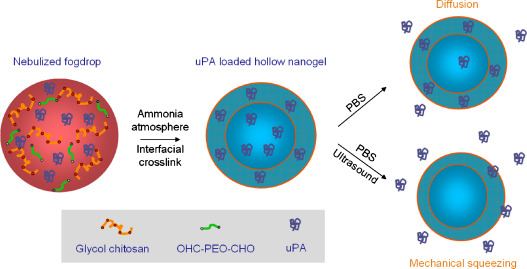
DOI: 10.1016/j.ijpharm.2012.06.001
http://www.sciencedirect.com/science/article/pii/S0378517312005984
4. Li, Jing; Wang, Yanhong; Zhang, Chengliang*; Liang, Fuxin; Qu, Xiaozhong; Li, Jiaoli; Wang, Qian; Qiu, Dong; Yang, Zhenzhong*. Janus Polymeric Cages, Polymer, 2012, 53(17): 3712-3718.
Janus polymeric cages are fabricated by Pickering emulsion interfacial polymerization. The modified silica particles are used to stabilize the emulsions. Oil-soluble monomers and water-soluble monomers copolymerized in between the voids among the silica particles at the interface, forming amphiphilic Janus polymer shell in which the silica particles are embedded. After removal of the silica particles and the oil core, the corresponding Janus polymeric cages are achieved with uniform and regularly arrayed holes across the shell. The Janus cages are permeable to both organic molecules and particles.

DOI: 10.1016/j.polymer.2012.06.001
http://www.sciencedirect.com/science/article/pii/S0032386112004909
5. Hu, DalinHu; Zhang, Xue; Zhang, Chengliang; Ding, Shujiang*; Yang, Zhenzhong*. Quaternized Polystyrene Composite Hollow Particles, Polymer, 2012, 53(17): 3802-3806.
In this paper, a general template synthesis approach is proposed to prepare composite hollow particles using quaternized polystyrene hollow particles. The crosslinked gel hollow templates are robust sufficiently to preserve their spherical contour during template synthesis. The gel shell with positively charged functional groups is infiltrative, and then a diversity of species can be loaded into the gel by electrostatic interaction. The grown materials are homogeneously distributed throughout the whole shell forming composite shells. The generality of the method is proved by extensive growth of the representative materials including metal Au nanoparticles, tungstenic acid and silica. The hollow particles with mesoporous shells are derived by further calcination to remove polymer templates, meanwhile composition of the shell can be transformed for example WC and C from H2WO4/quaternized polystyrene composite.
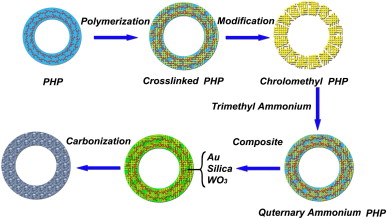
DOI: 10.1016/j.polymer.2012.06.021
http://www.sciencedirect.com/science/article/pii/S0032386112005101
6. Yu, Xianglin; Liang, Fuxin; Liu, Jiguang*; Lu, Yunfeng; Yang, Zhenzhong*. Mesoporous Hollow Spheres from Soap Bubbling, J. Colloid Interface Sci., 2012, 367(1): 531-536.
The smaller and more stable bubbles can be generated from the large parent bubbles by rupture. In the presence of a bubble blowing agent, hollow spheres can be prepared by bubbling a silica sol. Herein, the trapped gas inside the bubble acts as a template. When the porogen, i.e., other surfactant, is introduced, a mesostructured shell forms by the co-assembly with the silica sol during sol–gel process. Morphological evolution emphasizes the prerequisite of an intermediate interior gas flow rate and high exterior gas flow rate for hollow spheres. The method is valid for many compositions from inorganic, polymer to their composites.

DOI: 10.1016/j.jcis.2011.09.077
http://www.sciencedirect.com/science/article/pii/S0021979711012379
7. Tan, Hui; Jin, Haiqiang; Mei, Hongcheng; Zhu, Lijun; Wei, Wei; Wang, Qian; Liang, Fuxin; Zhang, Chengliang; Li, Jiaoli, Qu, Xiaozhong*; Shangguan, Dihua; Huang, Yining; Yang, Zhenzhong*. PEG-Urokinase Nanogels with Enhanced Stability and Controllable Bioactivity, Soft Matter, 2012, 8(9): 2644-2650.
Protein nanogels were synthesized via a one-step reaction procedure by crosslinking urokinase with benzaldehyde bifunctionalized poly(ethylene glycol). The crosslinked architecture significantly enhances the stability of urokinase against enzyme degradation in comparison with the core–shell structural PEGylated proteins. Meanwhile, bioactivity of the urokinase incorporated in the nanogels can be adjusted by varying the chain length of the corsslinking polymer. With a shorter crosslinker the bioactivity of the uPA nanogels is seriously restricted under physiological conditions. However, the restricted bioactivity can be completely launched by either enlarging the mesh size of the nanogel by using longer crosslinkers, or treating the nanogels in endosomal conditions to dissociate the nanogel structure due to the reversible conjugation chemistry.
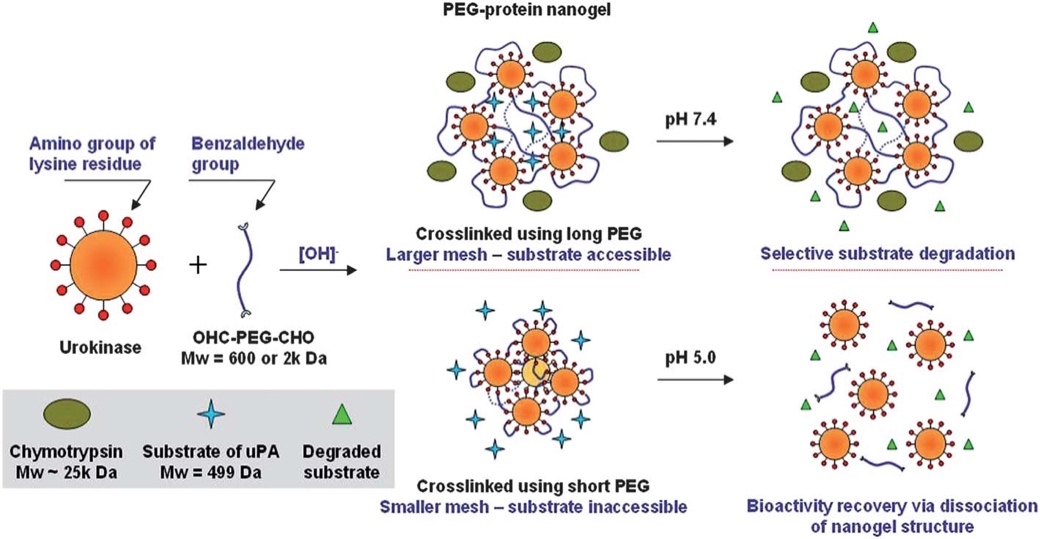
DOI: 10.1039/c2sm07072c
https://doi.org/10.1039/C2SM07072C
8. Guo, Jianfeng; Cheng, Woei Ping; Gu, Jingxia; Ding, Caixia; Qu, Xiaozhong; Yang, Zhenzhong; O’Driscolla, Caitriona*. Systemic Delivery of Therapeutic Small Interfering RNA Using a pH-Triggered Amphiphilic Poly-l-lysine Nanocarrier to Suppress Prostate Cancer Growth in Mice, Eur. J. Pharm. Sci., 2012, 45(5): 521-532.
Prostate cancer is associated with high mortality and new therapeutic strategies are necessary for improved patient outcome. The utilisation of potent, sequence-specific small interfering RNA (siRNA) to facilitate down-regulation of complementary mRNA sequences in vitro and in vivo has stimulated the development of siRNA-based cancer therapies. However, the lack of an effective siRNA delivery system significantly retards clinical application. Amphiphilic polycations with ‘stealth’ capacity have previously been synthesised by PEGylation of poly-l-lysine-cholic acid (PLL-CA). The benzoic imine linker between PEG and PLL-CA was designed to be stable at physiological pH but cleavable at lower pHs, consistent with the extracellular environment of tumours and the interior of endosomes/lysosomes. The selective hydrolysis of the PEG linker at these targeted sites should provide enhanced cellular uptake and endosomal escape while simultaneously ensuring prolonged blood circulation times. In this study, physicochemical profiling demonstrated nano-complex formation between the PLL derivatives and siRNA (200–280 nm in diameter). At physiological pH only a slight cationic surface charge (<20 mV) was detected, due to the masking effect of the PEG. In contrast, significantly higher positive charges (∼20 to 30 mV and >40 mV) were detected upon hydrolysis of the PEG linker at acidic pHs (pH = 6.8 and 5.5, respectively). The PEGylated complexes were stable in serum without significant aggregation or decomplexation of siRNA for up to 48 h. At the cellular level, PEG–PLLs were comparable with the commercial carrier INTERFRin™, in terms of cellular uptake, endosomal escape and in vitro reporter gene knockdown. In vivo, utilising a mouse model grafted with prostate carcinoma, significant tumour suppression was achieved using PEGylated complexes without marked toxicity or undesirable immunological response, this was accompanied by a simultaneous reduction in target mRNA levels. In summary, the advantages of these vectors include: the in vitro and in vivo silencing efficiency, and the low toxicity and immunogenicity.
DOI: 10.1016/j.ejps.2011.11.024
http://www.sciencedirect.com/science/article/pii/S0928098711004313
9. Chen, Ying Chen; Liang, Fuxin Liang*; Yang, Haili; Zhang, Chengliang; Wang, Qian; Qu, Xiaozhong; Li, Jiaoli; Cai, Yuanli*; Qiu, Dong; Yang, Zhenzhong*. Janus Nanosheets of Polymer-Inorganic Layered Composites, Macromolecules, 2012, 45(3): 1460-1467.
Janus nanosheets of polymer–inorganic layered composites are fabricated by crushing the corresponding Janus composite hollow spheres, which are synthesized by materialization of an amphiphilic emulsion interface with self-organized sol–gel process and subsequent polymer grafting onto the lipophilic side. The Janus composite nanosheets serve as solid surfactants to stabilize emulsion droplets, which are tolerant against solvents. Janus balance of the composite nanosheets is tunable crossing from more lipophilic to hydrophilic by alteration of polymer content. Thereafter, continuous phase of the emulsions can be inverted.

DOI: 10.1021/ma2021908
http://pubs.acs.org/doi/abs/10.1021/ma2021908
10. Wang, Dan; Jiao, Pengwei; Wang, Jianming; Zhang, Qiaolan; Feng, Lin*; Yang, Zhenzhong*. Fast Photo-Switched Wettability and Color of Surfaces Coated with Polymer Brushes Containing Spiropyran, J. Appl. Polym. Sci., 2012, 125(2): 870-875.
An intelligent photo-responsive spiropyran (SP)-contained surface that combines reversible wettability conversion with photochromic behavior was prepared on etched silicon substrates by atom transfer radical polymerization. The heterocyclic ring cleavage of SP moieties under UV irradiation leads to the change of the surface wettability and color. Water contact angle (CA) of the prepared surfaces change from 138.8° ± 1.3° to 42.7° ± 1.7° after 5 min under 365 nm UV irradiation and recover to its original state after 20 min of visible light irradiation, accompanied by the color change between yellowish and purple. To our knowledge, this result is the highest and fastest CA variation reported for surfaces containing SPs.
DOI: 10.1002/app.36254
https://doi.org/10.1002/app.36254
11. 胡大林, 张东阳, 张成亮, 丁书江*, 杨振忠*, “双亲性离子液体功能化复合胶体颗粒的合成与催化性能”, 高等学校化学学报, 2012, 33(10): 2345-2350.
采用硅烷偶联剂4-氯苄基三氯硅烷对二氧化硅颗粒表面进行改性,制得表面接枝氯苄基的亲油二氧化硅颗粒。在亲油二氧化硅颗粒表面继续接枝亲水性的十二烷基咪唑,即可制得含有离子液体基团的双亲性二氧化硅颗粒。通过静电吸附氯铂酸和硼氢化钠还原,可在两亲性二氧化硅颗粒表面负载铂纳米颗粒,从而得到双亲性二氧化硅颗粒催化剂。用扫描电镜、透射电镜、X射线衍射和红外光谱等对所得样品进行表征,并以苯甲醇氧化反应为研究对象对催化剂性能进行评价,结果显示,使用此催化剂可使苯甲酸的产率达到90%。

DOI: 10.7503/cjcu20111194
http://www.cjcu.jlu.edu.cn/CN/10.7503/cjcu20111194
12. 张成亮,韦玮,梁福鑫,杨振忠*,“Janu材料微结构精细调控进展”, 中国科学:化学,2012, 42(11): 1616-1626.
Janus材料由于其拥有两个具有不同化学组成的表面而备受关注,其特殊的结构和性能已成为材料科学研究热点。如何实现Janus材料形貌可控、化学组成严格分区、不同位点复合功能分区、微结构精细调控和批量化制备是该研究方向中的重点和难点。针对上诉问题,基于本课题组研究工作,本文总结了Janus材料微结构精确控制和批量化制备的方法,为Janus材料大规模制备和应用提供新思路和新方法。
DOI: 10.1360/032012-3
https://doi.org/10.1360/032012-3
13. 张东阳,张雪,丁书江*,郑元锁,杨振忠,“二氧化锡填充碳纳米管与锂离子存储性能”,中国科技论文,2012, 7(3): 170-174.
通过一种新颖的低温熔盐填充的方法成功地制备了二氧化锡(SnO2)填充碳纳米管(CNTs)的材料,SnO2的质量分数达到了60%。制备的复合材料相比于SnO2纳米颗粒,具有更高的锂离子存储容量,更好的充放电循环表现。良好的锂离子存储性能归功于独特的复合结构: 包覆的CNTs缓冲了SnO2在充放电过程中体积变化所引起的应力破坏,提供了额外的锂离子存储空间,并提高了整体材料的导电性。

2013
1. Deng, Renhua Deng; Liang, Fuxin Liang; Li, Weikun; Yang, Zhenzhong*; Zhu, Jintao*. Reversible Transformation of Nanostructured Polymer Particles, Macromolecules, 2013, 46(17): 7012-7017.
A reversible transformation of overall shape and internal structure as well as surface composition of nanostructured block copolymer particles is demonstrated by solvent-adsorption annealing. Polystyrene-b-poly(4-vinylpyridine) (PS-b-P4VP) pupa-like particles with PS and P4VP lamellar domains alternatively stacked can be obtained by self-assembly of the block copolymer under 3D soft confinement. Chloroform, a good solvent for both blocks, is selected to swell and anneal the pupa-like particles suspended in aqueous media. Reversible transformation between pupa-like and onion-like structures of the particles can be readily tuned by simply adjusting the particle/aqueous solution interfacial property. Interestingly, poly(vinyl alcohol) (PVA) concentration in the aqueous media plays a critical role in determining the particle morphology. High level of PVA concentration is favorable for pupa-like morphology, while extremely low concentration of PVA is favorable for the formation of onion-like particles. Moreover, the stimuli-response behavior of the particles can be highly suppressed through selective growth of Au nanoparticles within the P4VP domains. This strategy provides a new concept for the reversible transformation of nanostructured polymer particles, which will find potential applications in the field of sensing, detection, optical devices, drug delivery, and smart materials fabrication.
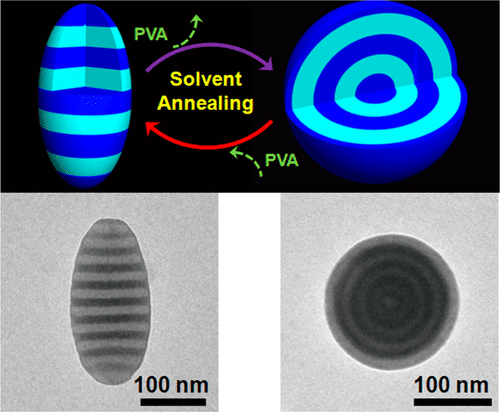
DOI: 10.1021/ma401398h
https://doi.org/10.1021/ma401398h
2. Liu, Zhen; Wang, Qian*; Liang, Fuxin; Qu, Xiaozhong; Zhang, Chengliang; Li, Jiaoli; Yang, Zhenzhong*. Responsive Nanotubular Organo-Gelator, Polymer, 2013, 54(18): 4948-4954.
A facile approach for the synthesis of responsive polymer composite nanotubular organogelators in large scale is reported. The exterior surface of the nanotubes is coarsening and hydrophobic after favorable growth of paramagnetic nanoparticles and oleic acid modification. All the tested organic solvents with varied polarities can be fast gelated by the addition of the composite nanotubular organogelators. The formed gel is easily removed from water with a magnet. A thermal responsive polymer PNIPAM is used to modify the surface of the composite nanotubes, it endows the release of captured oil from the gel by decreasing temperature. The composite nanotubular organogelators are promising in collecting chemical spills from water.

DOI: 10.1016/j.polymer.2013.07.026
https://doi.org/10.1016/j.polymer.2013.07.026
3. Han, BingHan; Wang, Xiaoyan*; Liu, Jiguang; Liang, Fuxin; Qu, Xiaozhong; Yang, Zhenzhong; Gao, Xuejun. The Biological Performanceof Calcium Hydroxide-Loaded Microcapsules, J Endod., 2013, 39(8): 1030-1034.
Calcium hydroxide (Ca[OH]2) microcapsules were synthesized for use in controlled release. The aim of this study was to evaluate the cytotoxicity, antibacterial properties, and influence on gene expression of bone-related markers of 2 different formulas of Ca(OH)2 microcapsules.
DOI: 10.1016/j.joen.2013.04.014
https://doi.org/10.1016/j.joen.2013.04.014
4. Zhao, Lingling; Zhu, Lijun; Chen, Ying; Wang, Qian; Li, Jiaoli; Zhang, Chengliang; Liang, Fuxin*; Qu, Xiaozhong*; Yang, Zhenzhong*. Janus Micro-Reactors, Chem. Commun., 2013, 49(55): 6161-6163.
Janus hollow spheres, with different compositions compartmentalized onto both interior and exterior surfaces of the same shell and P25 nanoparticles encapsulated in the cavities, are synthesized by the ultrasonic spray method to selectively enrich desired reagents in a confined environment for further reaction.
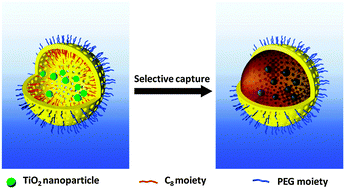
DOI: 10.1039/C3CC42505C
http://pubs.rsc.org/en/Content/ArticleLanding/2013/CC/c3cc42505c#!divAbstract
5. Zhu, Lijun; Huo, Pengfei; Wang, Qian; Liang, Fuxin; Zhang, Chengliang; Li, Jiaoli Qu, Xiaozhong*; Wang, Guibin*; Yang, Zhenzhong*. Photoluminescent Poly(ether ether ketone)-Quantum Dot Composite Films, Chem. Commun., 2013, 49(46): 5283-5285.
A fluoropoly(ether ether ketone) (FPEEK) demonstrating blue fluorescence was developed as a flexible, transparent membranous matrix for the incorporation of quantum dots (QDs) to fabricate a composite photoluminescent film which is promising as a self-referenced temperature sensor.
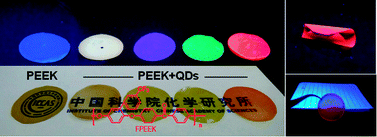
DOI: 10.1039/C3CC42074D
http://pubs.rsc.org/en/Content/ArticleLanding/2013/CC/c3cc42074d#!divAbstract
6. Chen, Ying; Yang, Haili; Zhang, Chengliang; Wang, Qian; Qu, Xiaozhong; Li, Jiaoli; Liang, Fuxin*; Yang, Zhenzhong*. Janus Cges of Bilayered Polymer-Inorganic Composites, Macromolecules, 2013, 46(10): 4126-4130.
Janus cages with a bilayer polymer–inorganic composite shell are synthesized by an emulsion interfacial self-organized sol–gel process followed by a polymer grafting onto the interior surface containing a vinyl group. Binary surfactants experience a phase separation to create transverse channels across the shell. The Janus cages can be functionalized by either growing responsive polymers or integrating with functional nanoparticles. They are promising in controlled loading and triggered release of desired materials under guidance.
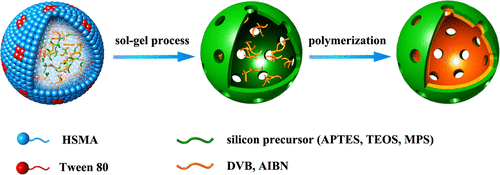
DOI: 10.1021/ma4006236
http://pubs.acs.org/doi/abs/10.1021/ma4006236
7. Yang, Haili; Liang, Fuxin*; Wang, Xing; Chen, Ying; Zhang, Chengliang; Wang, Qian; Qu, Xiaozhong; Li, Jiaoli; Wu, Decheng; Yang, Zhenzhong*. Responsive Janus Composite Nanosheets, Macromolecules, 2013, 46(7): 2754-2759.
A general approach is proposed to synthesize Janus polymer/inorganic composite nanosheets. Onto the amine-group-terminated side of the Janus inorganic nanosheets, initiators are covalently bonded. By a favorable grafting from initiator-terminated side, responsive polymers, for example PDEAEMA and PNIPAM, are synthesized by controlled polymerization for example ATRP or RAFT polymerization. Stable emulsions are easily formed in the presence of the Janus nanosheets, which can be easily de-emulsified by subtle changing physicochemical parameters, for example temperature and pH.
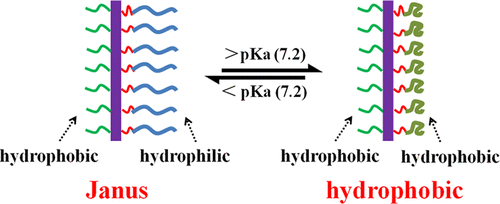
DOI: 10.1021/ma400261y
http://pubs.acs.org/doi/abs/10.1021/ma400261y
8. Chen, Hong; Xia, Lin; Fu, Wenxin; Yang, Zhenzhong*; Li, Zhibo*. One-Step Synthesis of Water Dispersible Silica Nanoplates, Chem. Commun., 2013, 49(13): 1300-1302.
We report the biomimetic synthesis of polyethylene glycol (PEG) grafted silica nanoplates templated by double hydrophilic PEG-b-poly-L-lysine diblock copolymers. The silica nanoplates can be re-dispersed in PEG selective solvents. The sizes of silica nanoplates can be tuned from a few hundred nanometers to tens of micrometers.

DOI: 10.1039/C2CC38293H
https://doi.org/10.1039/C2CC38293H
9. Tang, Chen; Zhang, Chengliang*; Sun, Yijing; Liang, Fuxin; Wang, Qian; Li, Jiaoli; Qu, Xiaozhong; Yang, Zhenzhong*. Janus Anisotropic Hybrid Particles with Tunable Size from Patchy Composite Spheres, Macromolecules, 2013, 46(1): 188-193.
We have developed a facile approach to synthesize anisotropic Janus hybrid particles by selective modification of bulgy patches on the composite spheres, which are in situ grown by phase separation during seeded emulsion polymerization. Janus particles are achieved by dissolution of the seed polymer particles. It is the key to control phase separation to form multiple bulges and tune their size by pH and monomer fraction. The size of the Janus particles is continuously tunable from submicrometer to nanometer scale. They can be massively synthesized since many bulges are derived from one seed sphere.

DOI: 10.1021/ma3020883
https://doi.org/10.1021/ma3020883
10. Rong, Jianhua; Ji, Lijun Ji; Yang, Zhenzhong*. Some Key Ordered Macroporous Composites, Chin. J. Polym. Sci., 2013, 31: 1204-1217.
This review summarizes recent progress of the ordered macroporous composites with the opals and inverse opal structure. Synthesis and performance of the composites are emphasized. Composition of the ordered composites is tunable ranging within metal, metal alloy, metal oxide, polymer, carbon and hydrogel. The ordered structure gives brilliant color effects, which is useful for sensors and photonic crystals. The interconnected macroporous structure provides easiness for mass transportation and species culturing.
DOI: 10.1007/s10118-013-1324-6
https://link.springer.com/article/10.1007/s10118-013-1324-6
11. Cheng, Wenguang; Li, Wenzhe; Ji, Shaofei; Yang, Dandan; Wang, Liduo; Qu, Xiaozhong, Zhang, Chengliang; Liang, Fuxin; Wang, Qian; Li, Jiaoli*; Yang, Zhenzhong*. Oriented Mesoporous TiO2 Film as Photoanode Fordye-Sensitized Solar Cells, J. Mater. Chem. A, 2013, 1(27): 8023-8028.
Flexible bicontinuous mesostructured polymer/inorganic composite membranes was prepared by undertaking co-assembly of surfactants and inorganic sol–gel processes inside pores of a preformed porous polymer membrane. After burning off the organic component, the oriented mesoporous TiO2 film was obtained. The three dimensional porous structure was carefully investigated, and a DSSC was fabricated using the obtained TiO2 film as photoanode. The method of incorporating surfactant induced self-organizing sol–gel process and a certain nanoporous template was proved to be a useful technique to create different kinds of nano-/mesoporous structures.
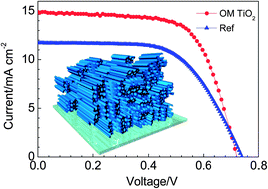
DOI: 10.1039/C3TA11636K
https://doi.org/10.1039/C3TA11636K
12. Yang, Zhenglong; Li, Jiaoli; Zhang, Chengliang; Lu, Yunfeng; Yang, Zhenzhong*. Two-Dimensional Mesoporous Materials: from Fragile Coatings to Flexible Membranes, Chin. Chem. Lett., 2013, 24(2): 89-92.
This paper reviews the progress of two-dimensional mesoporous materials including their synthesis strategy, mesostructure, composition, surface property, flexibility, and potential applications. During the past two decades, research on two-dimensional mesoporous materials has experienced an evolution from fragile coatings to flexible membranes. Aiming at practical applications, it is significant to support mesoporous materials with proper matrices for example porous membranes especially flexible ones to form mesoporous composite membranes with designed pore size and chemistry.
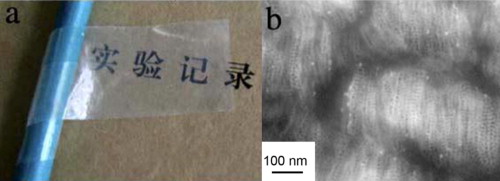
DOI: 10.1016/j.cclet.2013.01.008
https://doi.org/10.1016/j.cclet.2013.01.008
13. Xu, Guiheng; Xu, Qun*; Qin, Anjun; Cheng, Jingtao; Wang, Nan; Wei, Junyi; Zhang, Chengliang; Yang, Zhenzhong*; Tang, Ben Zhong*. Immobilization of Polymeric Fluorogen on PDVB Nanotubes with the Assistance of Supercritical CO2 for Functional Films, J. Mater. Chem. C, 2013, 1(9): 1717-1721.
We report a facile method for the fabrication of a nanocomposite that consists of AIE-active poly(aroxycarbonyltriazole) PACT polymer uniformly decorated on polydivinylbenzene (PDVB) nanotubes in the form of nanoparticles via the supercritical carbon dioxide (SC CO2)-assisted method. The on/off fluorescence switching for organic vapor and solvent was demonstrated with PACT/PDVB nanocomposite films.

DOI: 10.1039/C3TC00827
https://doi.org/10.1039/C3TC00827D
14. 刘军, 薛文瑞, 赵玲玲, 屈小中, 杨振忠, 李睿, 邓世洲, 肖飞, 胡小鹏, 白文俊, “治疗勃起功能障碍的高分子/基因复合药物控释体系建立与性能研究”, 中华男科学杂志, 2013, 19, 771-775.
目的: 针对ED治疗方法的不足,设计和制备新型高效的高分子/基因复合药物控释体系,探讨pH、温度双敏感水凝胶体系在ED基因治疗中的可行性。方法: 对聚赖氨酸/小干扰RNA(PLL/siRNA)基因复合物进行Zeta电位表征,制备最佳的siRNA基因纳米颗粒; 以聚乙二醇-聚丙二醇-聚乙二醇嵌段共聚物(PEO-PPOPEO)为交联单元,通过化学改性在其两端引入苯甲醛基团,使其与壳聚糖反应形成苯甲酰亚胺键,从而制备pH、温度双敏感可注射基因药物控释体系,并对不同温度下控释体系的释放情况进行检测。结果: 当PLL∶siRNA质量比为20∶1时,复合物的Zeta电势达到最大正值(+23.5 mV),siRNA被PLL最大程度的包裹; 将环境pH由酸性(5.5)调至中性(7.4),壳聚糖和交联剂发生Schiff反应而交联,形成水凝胶; 体系内包覆的siRNA在37℃时保持低释放,升高温度至60℃后释放量大幅增加,至1 000 min时,60℃条件下的累计释放量为(122.5±5.3)μg,而37℃下仅为(23.8±6.0)μg(P<0.05)。结论: 成功制备高分子/基因复合药物控释体系,在保证基因药物高靶向性的同时,提高了基因载体的稳定性和容量,并实现siRNA的温控释放,将有望成为ED基因药物治疗中的新材料,为简捷方便的按需给药提供新手段。
DOI: 10.13263/j.cnki.nja.2013.09.007
https://doi.org/10.13263/j.cnki.nja.2013.09.007
2014
1. Liu, Xueli; Zhang, Feilong; Wang, Qian; Gao, Jun; Meng, Jingxin; Wang, Shutao*; Yang, Zhenzhong*; Jiang, Lei. Platelet-Inspired Multiscaled Cytophilic Interfaces with High Specificity and Efficiency toward Point-of-Care Cancer Diagnosis, Small, 2014, 10(22): 4677-4683.
Inspired by the interactions between platelets and tumor cells, multiscaled cytophilic interfaces are fabricated by assembling platelet-mimicking microspheres via oxidative polymerization of polyaniline nanohairs through transverse nanochannels in the shells of hollow polystyrene microspheres, and modifying specific recognition molecules. This interface realizes efficient tumor-cell recognition and isolation from artificial blood, suggesting a new platform for metastasis diagnosis and cancer treatment.
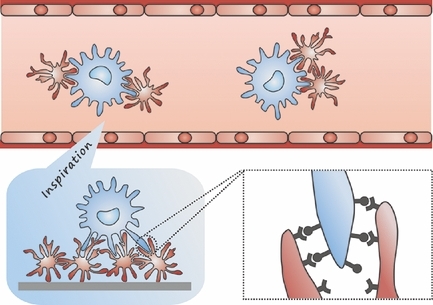
DOI: 10.1002/smll.201401530.
https://doi.org/10.1002/smll.201401530
2. Liang, Fuxin; Zhang, Chengliang; Yang, Zhenzhong*. Rational Design and Synthesis of Janus Composites, Adv. Mater., 2014, 26(40): 6944-6949.
Janus composites with two different components divided on the same object have gained growing interest in many fields, such as solid emulsion stabilizers, sensors, optical probes and self-propellers. Over the past twenty years, various synthesis methods have been developed including Pickering emulsion interfacial modification, block copolymer self-assembly, microfluidics, electro co-jetting, and swelling emulsion polymerization. Anisotropic shape and asymmetric spatial distribution of compositions and functionalities determine their unique performances. Rational design and large scale synthesis of functional Janus materials are crucial for the systematical characterization of performance and exploitation of practical applications.
DOI: 10.1002/adma.201305415
https://doi.org/10.1002/adma.201305415
3. Zhu, Lijun; Yang, Saina; Qu, Xiaozhong*; Zhu, Feiyan; Liang, Yongri; Liang, Fuxin; Wang, Qian; Li, Jiaoli; Li, Zhibo; Yang, Zhenzhong*. Fibril-Shaped Aggregates of Doxorubicin with Poly-L-lysine and its Derivative, Polym. Chem., 2014, 5(19): 5700-5706.
Complex formation between polymers and organic molecules is an interesting topic in polymer physics. Compared to the influence of small molecules on polymer assembly, there are fewer examples demonstrating the effect of polymers on the supramolecular structures formed by organic molecules. In this paper, we first prove that doxorubicin (DOX), a common anti-tumour drug, assembles into fibril-like aggregates in phosphate buffer (pH 7.4) and then show that the assembly of DOX was influenced by the complexation with an amphiphilic poly (amino acid) derivative, i.e. cholate-grafted poly-L-lysine (PLL-CA). With PLL-CA, the DOX fibrils converted to helix structured nano-spindles, whilst the presence of PLL led to minor change on the morphology of PLL/DOX complex compared to the DOX aggregates, which is attributed to the amplitude of intermolecular interactions. As a DNA intercalating agent, the aggregation of DOX on its biofunctionality was also investigated, showing that the formation of fibril assemblies was unfavourable for the cellular internalization of DOX and caused lower cytotoxicity to DOX resistance MCF-7 cells, whereas the polymer/DOX complexes gained an improved cell uptake on the MCF-7/ADR cell line due to an enhanced electrostatic interaction between the complexes and the cell membrane.

DOI: 10.1039/C4PY00686K
https://doi.org/10.1039/C4PY00686K
4. Deng, Renhua; Liang, Fuxin*; Zhou, Peng; Zhang, Chengliang; Qu, Xiaozhong; Wang, Qian; Li, Jiaoli; Zhu, Jintao*; Yang, Zhenzhong*. Janus Nanodisc of Diblock Copolymers, Adv. Mater., 2014, 26(26): 4469-4472.
Janus nanodiscs of diblock copolymers are prepared by stepwise disassembly of PS-b-P4VP disc-stacked particles. The Janus nanodiscs are uniform in thickness and regular in contour. By preferential growth of functional materials at the positively charged P4VP side, the composition, microstructure, and performance of the Janus nanodiscs are tunable.
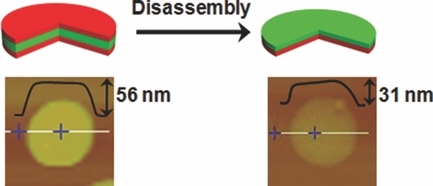
DOI: 10.1002/adma.201305849
https://doi.org/10.1002/adma.201305849
5. Wang, Lei; Qiu, Lihua; Yang, Zhenzhong*; Yan, Feng*. Low-Dose Imidazolium Cation Grafted Polymeric Nanotubes for Quasi-Solid-State Dye-Sensitized Solar Cells, Electrochim. Acta, 2014, 133: 446-452.
Poly(divinybenzene-co-chloromethylstyrene) (poly(DVB-co-VBC)) nanotubes (PDVBVBC-NT) and imidazolium surface functionalized poly(DVB-co-VBC) (Im-PDVBVBC-NT) are synthesized by cationic polymerization and utilized as the gelators for ionic liquid based gel electrolytes. Compared with the synthesized pristine PDVBVBC-NT, Im-PDVBVBC-NT (a gelator dose as low as 1 wt%) based gel electrolytes show higher ionic conductivity and diffusion coefficient. The fabricated DSSCs based on Im-PDVBVBC-NT gel electrolyte show a power conversion efficiency of 4.9% and 5.5% under a simulated air mass 1.5 solar spectrum illumination at 100 mW cm−2 and 50 mW cm−2, respectively. Furthermore, Im-PDVBVBC-NT based DSSCs show better long-term stability than that with ionic liquid electrolyte, which indicated that Im-PDVBVBC-NT based gel electrolytes could overcome the leakage problems of the cells with pure ionic liquid electrolytes.
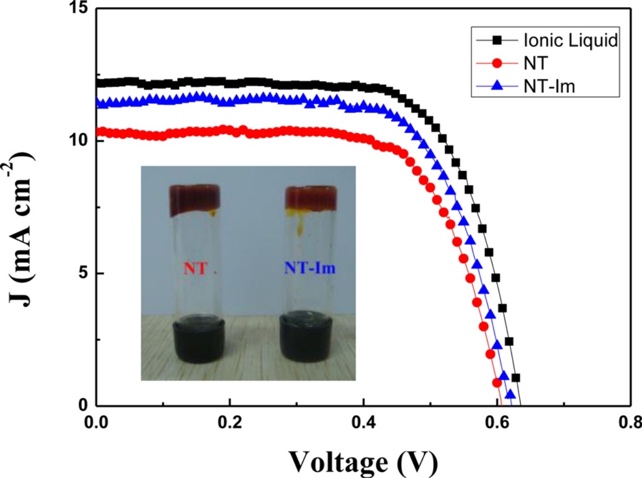
DOI: 10.1016/j.electacta.2014.04.124
https://doi.org/10.1016/j.electacta.2014.04.124
6. Deng, Renhua; Liu, Shanqin; Liang, Fuxin*; Wang, Ke; Zhu, Jintao*; Yang, Zhenzhong*. Polymeric Janus Particles with Hierarchical Structures; Macromolecules, 2014, 47(11): 3701-3707.
Janus colloidal particles with hierarchical structures are generated by phase separation of diblock copolymer polystyrene-block-poly(4-vinylpyridine) (PS-b-P4VP) and homopolymer poly(methyl methacrylate) (PMMA) binary blends in confined geometry. The dependence of their morphology on the copolymer composition, solvent selectivity, particle size, and polymer/aqueous solution interfacial property was investigated. By varying the particle/aqueous solution interfacial property alternately, the Janus particles exhibited a reversible morphological transformation under solvent-adsorption annealing process. In addition, by introducing 3-n-pentadecyphenol (PDP) which can hydrogen bond with P4VP to form supramolecules, the structure of the Janus particles can be well tuned. Furthermore, due to the complexation of pyridine unit with Au precursor, composite Janus particles with Au nanoparticles selectively incorporated in P4VP microdomains can be easily manipulated.
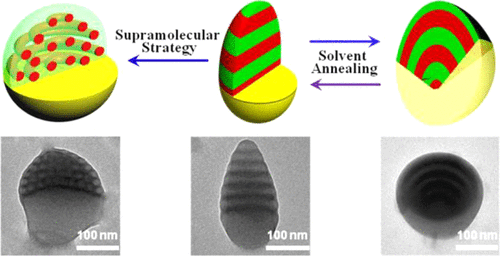
DOI: 10.1021/ma500331w
https://doi.org/10.1021/ma500331w
7. Ji, Xuyang; Zhang, Qian Zhang; Liang, Fuxin; Chen, Qinan; Qu, Xiaozhong; Zhang, Chengliang; Wang, Qian; Li, Jiaoli; Song, Ximing*; Yang, Zhenzhong*. Ionic Liquid Functionalized Janus Nanosheets, Chem. Commun., 2014, 50(43): 5706-5709.
Ionic liquid functionalized Janus nanosheets are synthesized by selective treatment of the imidazolin terminated side of Janus nanosheets while the other side is preserved. The Janus performance of the nanosheets and thus emulsion stability are reversibly triggered by anion exchange.
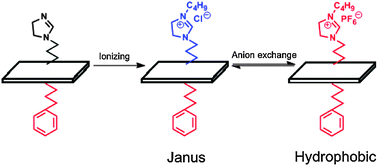
DOI: 10.1039/C4CC00649F
https://doi.org/10.1039/C4CC00649F
8. Wu, Xiao; Qiu Lihua; Yang, Zhenzhong*; Yan, Feng*. Imidazolium Functionalized NT-Im-Au-Ag Hybrids for Surface-Enhanced Raman Scattering and Catalytic Reduction of 4-Nitrophenol, Appl. Catal., A, 2014, 478: 30-37.
A facile and effective procedure for the preparation of poly(divinybenzene-co-chloromethylstyrene) (poly(DVB-co-VBC)) nanotube/Au-Ag nanoparticle composite (NT-Im-Au-Ag) via using covalently attached imidazolium as linkers was reported. The approach involves the surface functionalization of poly(DVB-co-VBC) NTs with imidazolium cation, anion-exchange with Au precursor (HAuCl4) and followed by the reduction of metal ions. The obtained NT-Im-Au nanoparticle composite was further used as the seeds to produce NT-Im-Au-Ag nanoparticle composite. The morphology and optical properties of the produced nanohybrids were characterized by transmission electron microscopy (TEM), energy dispersive X-ray (EDX) spectroscopy. The as-prepared NT-Im-Au-Ag nanohybrids show an extremely suitable substrate for surface-enhanced Raman spectroscopy (SERS) with a high enhancement factor of 6.7 × 107, enabling the detection of 10−12 M Rhodamine 6G solution. The catalytic performance of NT-Im-Au-Ag nanohybrids was studied by the reduction of 4-nitrophenol with NaBH4 as a reducing agent. Their reaction rate constant was calculated according to the pseudo-first-order reaction equation.

DOI: 10.1016/j.apcata.2014.03.026
https://doi.org/10.1016/j.apcata.2014.03.026
9. Jiang, Wei; Yang, Zheng-Long*; Weng, Ding; Wang, Jun-Wei; Lu, Yun-Feng*; Zhang, Min-Juan; Yang, Zhenzhong*. Solvothermal Synthesis of PbTe/SnTe Hybrid Nanocrystals, Chin. Chem. Lett., 2014, 25(6): 849-853.
PbTe/SnTe hybrid nanocrystals with designed shape, chemical composition and narrow size distribution were synthesized by an efficient solvothermal approach. This approach enables mass and economical synthesis of PbTe-based nanocrystals. The organic ligands were completely removed by pretreatment with a super-hydride solution, making it possible to fabricate fully dense and robust thermoelectric devices with increased electrical conductivity.

DOI: 10.1016/j.cclet.2014.03.031
https://doi.org/10.1016/j.cclet.2014.03.031
10. Deng, Renhua; Liang, Fuxin; Li, Weikun; Liu, Shanqin; Liang, Ruijing; Cai, Mingle; Yang, Zhenzhong*; Zhu, Jintao*. Shaping Functional Nano-Objects by 3D Confined Supramolecular Assembly, Small, 2014, 9(24): 4099-4103.
Nano-objects are generated through 3D confined supramolecular assembly, followed by a sequential disintegration by rupturing the hydrogen bonding. The shape of the nano-objects is tunable, ranging from nano-disc, nano-cup, to nano-toroid. The nano-objects are pH-responsive. Functional materials for example inorganic or metal nanoparticles are easily complexed onto the external surface, to extend both composition and microstructure of the nano-objects.
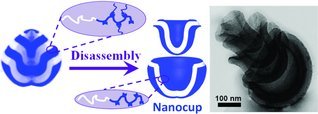
DOI: 10.1002/smll.201300271
https://doi.org/10.1002/smll.201300271
11. 李焦丽,张成亮, 梁福鑫,杨振忠*,“锂离子动力电池隔膜的研究及发展现状”,中国科学: 化学, 2014, 44(7): 1116-1124.
锂离子动力电池作为新能源汽车的动力之源受到广泛关注。本文对动力电池的重要组件之一——电池隔膜进行了介绍。围绕提高安全性和能量密度的设计目标,综述了其新材料、新技术的发展及现状。
DOI: 10.1360/N032014-00043
https://doi.org/10.1360/N032014-00043
2015
1. Liu, Yijiang; Liang, Fuxin*; Wang, Qian; Qu, Xiaozhong; Yang, Zhenzhong*. Flexible Responsive Janus Nanosheets, Chem. Commun., 2015, 51(17): 3562-3565.
Flexible Janus nanosheets of molecular scale thickness (3.5 nm) are massively fabricated by a sol–gel process of a self-assembled monolayer of an amphiphilic silane onto a template. Groups of both sides are tuneable, and thus performance of the nanosheets, for example, is pH responsive. As a flexible solid emulsifier, the desired species can be wrapped with an individual nanosheet, which is pH triggered.

DOI: 10.1039/c4cc08420a
https://doi.org/10.1039/C4CC08420A
2. Deng, Renhua; Liang, Fuxin*; Qu Xiaozhong; Wang, Qian; Zhu, Jintao*; Yang, Zhenzhong*. Diblock Copolymer Based Janus Nanoparticles, Macromolecules, 2015, 48(3): 750-755.
We present a facile and versatile approach to prepare diblock copolymer based Janus nanoparticles (NPs). Diblock copolymer PS-b-P4VP can self-assemble into patchy particles with P4VP protuberances on their surface using the emulsion solvent evaporation method. After cross-linking the P4VP protuberances, Janus NPs are produced by disassembling the particles. Within the P4VP domains, other species including metallic and inorganic are preferentially grown to extend composition and functionality. The Janus NPs are amphiphilic and capable to self-organize into superstructures. The size ratio of P4VP/PS and thus the Janus balance of the NPs are tunable by changing block chain length ratio of the block copolymers.
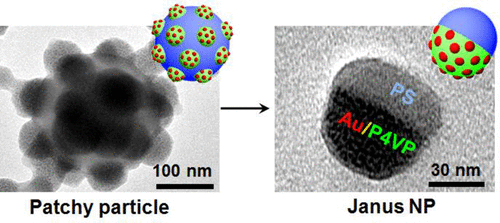
DOI: 10.1021/ma502339s
https://doi.org/10.1021/ma502339s
3. Zhao, Hua; Liang, Fuxin*; Qu, Xiaozhong; Wang, Qian; Yang, Zhenzhong*. Conelike Janus Composite Particles, Macromolecules, 2015, 48(3): 700-706.
Conelike cross-linked PS particles are polymerized at a patchy emulsion interface. The PS particles synthesized in the dispersed paraffin phase immigrate toward the interface due to the Pickering effect. At the triple phase contact line, the particles are squeezed into cone shape under an outward convex interfacial tension mismatch. The conelike PS particles are adhered to paraffin sphere surface and synchronously protected, which allows selective modifications of the two sides. The Janus particles can self-organize into superstructures in dispersions. Robust coatings are easily fabricated from the Janus particles, whose wettability is tunable from highly adhesive for water to superhydrophobic by simply changing the size distribution of the Janus particles.

DOI: 10.1021/ma502421z
https://doi.org/10.1021/ma502421z
4. Yang, Saina; Zhu, Feiyan; Wang, Qian; Liang, Fuxin; Qu, Xiaozhong*; Gan, Zhihua*; Yang, Zhenzhong*. Combinatorial Targeting Polymeric Micelles Foranti-Tumor Drug Delivery, J. Mater. Chem. B, 2015, 3(19): 4043-4051.
Polymeric micelles of amphiphilic block copolymers have been studied for decades for their application as a targeting delivery agent of anti-tumor drugs. However, the targeting micelles may cause an immunological response because of the surface distributed ligands. In this work, mixed micelles were developed to improve the specificity of cancer cell uptake under tumor-acidic conditions. This was achieved by the co-assembly of an active targeting amphiphilic polymer, i.e. cyclic (Arg-Gly-Asp-D-Phe-Lys) c(RGDfK) functionalized poly(ethylene oxide)-b-poly(ε-caprolactone) (cRGD-PEO-b-PCL), and a pH sensitive drug conjugate, i.e. benzoic-imine linked PEGylated doxorubicin (PEG-DOX). Because the PEG-DOX is cleavable at the extracellular pH of a solid tumor, the characteristics of the mixed micelles turn from “stealthy” to cancer cell-affinitive due to the detachment of PEG from the micelle surface and hence allow the action of the c(RGDfK) in the cRGD-PEO-b-PCL with the cancer cell membrane. Besides, the mixed micelles exhibited the capacity for encapsulating hydrophobic drugs such as paclitaxel to form a combination formulation. Our results indicate that co-assembly is a facile but efficient strategy to coordinate the characteristics of each individual component and thus provide combinatorial functions to the delivery system.
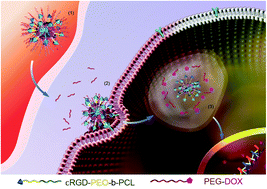
DOI: 10.1039/c5tb00347d
https://doi.org/10.1039/C5TB00347D
5. Liu, Yijiang; Wang, Qian; Qu, Xiaozhong; Liang, Fuxin*; Yang, Zhenzhong*. Amine/Acid Composite Janus Nanosheets, Sci. China Mater., 2015, 58: 126-131.
Janus materials have witnessed fast development due to their diversified promising performances and practical applications. Compared with their spherical counterparts, Janus nanosheets have gained more concerns for their highly anisotropic shape besides chemistry. Herein, 3.5 nm ultrathin and flexible Janus nanosheets with carboxyl group terminated onto one side are fabricated by surface sol-gel process of the self-assembled monolayer of an amphiphilic silane onto the template CaCO3 particle firstly. Amine/acid composite Janus nanosheets are further derived from these carboxyl group terminated silica Janus nanosheets by selective conjugation with amine groups onto the other side. The amine/acid composite Janus nanosheets are dually pH responsive, and well dispersible in aqueous solution at both low and high pH levels. The nanosheets are aggregated forming multi-layered face-to-back superstructures at intermediate pH levels. This is originated by the opposite electrostatic interaction between the carboxyl and the amine groups. This approach can be extended to other silanes, and a huge family of Janus nanosheets is expected with tunable composition and performance.
DOI:10.1007/s40843-015-0027-4
https://link.springer.com/article/10.1007/s40843-015-0027-4
6. Wang, Qiguang; Liang, Fuxin*; Wang, Qian; Qu, Xiaozhong; Yang, Zhenzhong*. Responsive Composite Janus Cages, Chin. J. Polym. Sci., 2015, 33: 1462-1469.
pH responsive composite Janus cages of PS-silica-PEO are prepared using silica nanoparticles to crosslink two PAA contained di-block copolymers at an emulsion interface sequentially. Transverse channels are in situ created across the shell, which facilitates mass transfer. Shell is pH responsive owing to the presence of residual PAA chains tethered onto the silica nanoparticles. The Janus cages are capable to preferentially capture oil from their aqueous surroundings. The saturation absorption capacity is determined by pH and oil property. Other composite Janus cages are expected by extension the method using other copolymers and functional nanoparticles.
DOI:10.1007/s10118-015-1691-2
https://link.springer.com/article/10.1007/s10118-015-1691-2
7. Zhou, Peng; Wang, Qian*; Zhang, Chengliang; Liang, Fuxin; Qu, Xiaozhong; Li, Jiaoli; Yang, Zhenzhong*. pH Responsive Janus Polymeric Nanosheets, Chin. Chem. Lett., 2015, 26(6): 657-661.
pH responsive polymeric Janus nanosheets with poly(maleic acid) moiety and crosslinked PS onto the corresponding sides have been synthesized by free radical polymerization. The Janus nanosheets can serve as solid emulsifier to stabilize an oil/water emulsion, whose stability is easily triggered by changing pH across pKa of the poly(maleic acid).
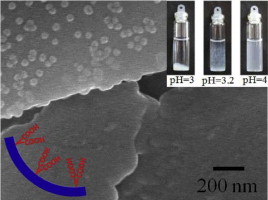
DOI:10.1016/j.cclet.2015.04.006
https://www.sciencedirect.com/science/article/pii/S1001841715001357
8. Zhao, Ziguang Zhao; Liang, Fuxin*; Zhang, Guolin; Ji, Xuyang; Wang, Qian; Qu, Xiaozhong; Song, Ximing; Yang, Zhenzhong*. Dually Responsive Janus Composite Nanosheets, Macromolecules, 2015, 48(11): 3598-3603.
Janus composite nanosheets of PNIPAM/silica/PDEAEMA are synthesized by sequential ATRP grafting two polymers from the corresponding sides of the Janus silica nanosheets. They are dually responsive to pH and temperature since wettability of the two sides is tunable accordingly. The nanosheets can serve as a responsive solid emulsifier. Type and stability of the emulsions are triggered by simply changing pH and temperature.
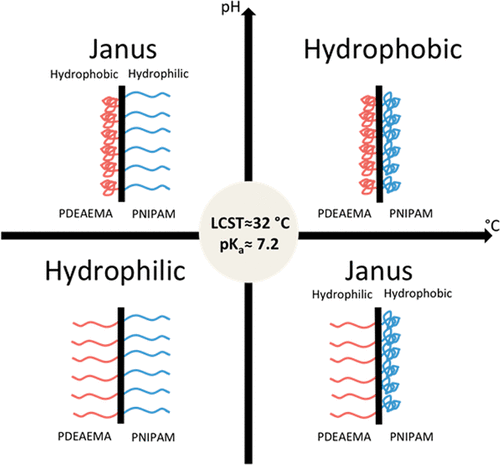
DOI:10.1021/acs.macromol.5b00365
https://pubs.acs.org/doi/abs/10.1021/acs.macromol.5b00365
9. Lv, Dongmei; Ni, Wei; Liang, Fuxin*; Wang, Qian; Qu, Xiaozhong; Yang, Zhenzhong*. One-Dimensional Janus Polymeric Vehicles, Chin. J. Polym. Sci., 2015, 33: 1344-1350.
We herein report a novel approach to fabricate poly(DVB-co-VBC) one-dimentional nanomaterials with varied composition. By adjusting the monomer DVB/VBC ratio and using inert solvents, after internal cavity of the nanotubes disappears and length of the nanotubes is decreased, thus nanorods are achieved. After quaternary ammoniation from the benzyl chloride group, the exterior surface becomes hydrophilic while the interiority preserves hydrophobic. The Janus nanorods can serve as a specific vehicle to selectively collect oils from their aqueous surroundings.
DOI: 10.1007/s10118-015-1683-2
https://link.springer.com/article/10.1007/s10118-015-1683-2
10. Ji, Xuyang; Zhang, Qian; Qu, Xiaozhong; Wang, Qian; Song, Xi-Ming*; Liang, Fuxin*; Yang, Zhenzhong. Poly(ionic liquid) Janus Nanosheets towards Dye Degradation, RSC Adv., 2015, 5(28): 21877-21880.
Polymeric ionic liquid (PIL) functionalized Janus nanosheets are synthesized by polymerization of ionic liquid monomers onto the ATRP agent modified side of the silica Janus nanosheets. PW12O403− anion is introduced onto the PIL side through anion exchange. The PW12O403− based PIL Janus nanosheets at the emulsion interface exhibit excellent catalytic degradation of water soluble dyes for example methyl orange (MO).
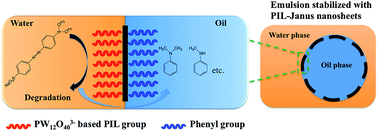
DOI: 10.1039/C5RA02330K
https://doi.org/10.1039/C5RA02330K
11. Wang, Qiguang; Liu, Yijiang; Qu, Xiaozhong; Wang, Qian; Liang, Fuxin*; Yang, Zhenzhong*. Janus Nanosheets by Emulsion Interfacial Crosslinking of Reactive Surfactants, Colloid Polym. Sci., 2015, 293: 2609-2615.
Polymeric Janus nanosheets are synthesized by crosslinking the self-assembled monolayer formed by a reactive polymer surfactant at an oil/water interface. At low temperature, while the hydrophobic segments are frozen by the internal phase of solid paraffin, the reactive hydrophilic carboxylic acid groups exposed to the external aqueous phase can be selectively crosslinked to form an intact nanomembrane. The Janus nanosheets can be created after breaking the nanomembrane into pieces under ultrasonication during dissolution of the paraffin phase. Many approaches can be used to crosslink the nanomembrane at the interface, for example multiple amines and multivalent cationic ions. The polymeric Janus nanosheets can be easily functionalized to derive a series of composite nanosheets. The composite Janus nanosheets can serve as new solid surfactants which are responsive to pH or magnetic field.

DOI: 10.1007/s00396-015-3649-x
https://link.springer.com/article/10.1007/s00396-015-3649-x
12. Sun, Yijing; Liang, Fuxin*; Qu, Xiaozhong; Wang, Qian; Yang, Zhenzhong*. Robust Reactive Janus Composite Particles of Snowman Shape, Macromolecules, 2015, 48(8): 2715-2722.
We present a facile approach toward snowman-like silica@PDVB/PS Janus particles by seed emulsion polymerization using a gelable monomer MPS against a PDVB/PS hollow particle. Individual silica bulge is protruded from the seed particle surface, whose size is tunable. The silica@PDVBJanus particles are derived after dissolution of PS, which are robust to tolerate against organic solvents. Both sides are reactive for selective modifications to grow desired materials with tunable wettability and functionality. As solid emulsifiers, the Janus balance of the particles is tunable from more hydrophobic to more hydrophilic by changing either aspect size ratio or composition of the two sides.
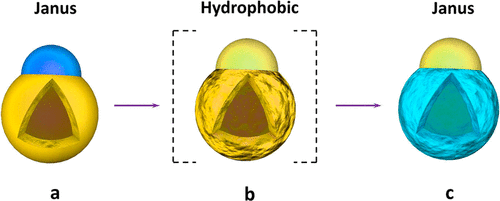
DOI: 10.1021/acs.macromol.5b00207
https://pubs.acs.org/doi/abs/10.1021/acs.macromol.5b00207
13. Yang, Haili; Liang, Fuxin*; Chen, Ying; Wang, Qian; Qu, Xiaozhong; Yang, Zhenzhong*. Lotus Leaf Inspired Robust Superhydrophobic Coating from Strawberry-Like Janus Particles, NPG Asia Mater., 2015, 7: e176.
We demonstrate a one-step approach toward the large-scale fabrication of robust superhydrophobic coatings using strawberry-like hemispherical Janus particles. Hemispherical Janus particles are capable of self-organizing into a layer on substrates. Nanoscale roughness on the hydrophobic hemispherical side determines the superhydrophobic performance. The imidazolin group on the hydrophilic flat side determines the coating strength by covalent binding onto substrates via cations initiating the crosslinking of the intermediate epoxy resins. The coating can tolerate organic solvents and high water flushing speeds. If the hydrophobic side is smooth, then the coating is highly adhesive to water. This procedure can fabricate unique coatings on a diverse range of substrates with varied compositions and shapes.
DOI: 10.1038/am.2015.33
https://www.nature.com/articles/am201533
14. Cui, Shuqin; Ji, Xuyang; Liang, Fuxin*; Yang, Zhenzhong*. Ionic Liquid Functionalized Polymer Composite Nnanotubes towards Dye Decomposition, Chin. Chem. Lett., 2015, 26(8): 942-945.
Poly(ionic liquid) functionalized composite nanotubes are achieved by ATRP grafting ionic liquid monomers for example ViEtIm+Br− from the poly(DVB-co-VBC) nanotubes surface. PW12O403− anion is introduced through anion exchange. The PW12O403− based composite nanotubes can synchronously absorb and decompose water soluble dyes for example methyl orange (MO). The cooperative interplay is promising in highly efficient decomposition of dyes.
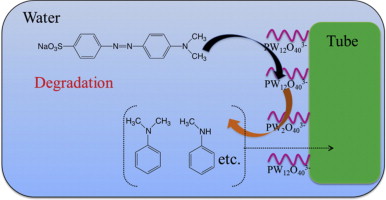
DOI: 10.1016/j.cclet.2015.04.034
https://www.sciencedirect.com/science/article/pii/S1001841715001795
15. Cao, Ziquan; Wang, Guojie*; Chen, Ying; Liang, Fuxin; Yang, Zhenzhong*. Light-Triggered Responsive Janus Composite Nanosheets, Macromolecules, 2015, 48(19): 7256-7261.
We report the synthesis of light-triggered Janus composite nanosheets and their Janus performance. Onto the amine-group terminated side of silica Janus nanosheets, a photo-responsive spiropyran-containing polymer (PSPMA) brush has been prepared by ATRP, while the other side terminated with hydrophobic octyl groups is preserved. Upon UV irradiation, the hydrophobic PSPMA side becomes hydrophilic since the hydrophobic spiropyran changes to the hydrophilic zwitterionic merocyanine form (or vice versa with visible light). Consequently, the PSPMA/silica composite nanosheets become Janus from hydrophobic or vice versa. The Janus composite nanosheets can serve as a responsive solid emulsifier, thus the stability of the emulsions can be remotely triggered with light. Unlike those pH- or temperature-responsive Janus materials, the light-triggering process requires no additional input of chemicals or thermal energy.

DOI: 10.1021/acs.macromol.5b01257
https://pubs.acs.org/doi/10.1021/acs.macromol.5b01257
16. Deng, Renhua; Li, Hui; Liang, Fuxin; Zhu, Jintao*; Li, Baohui*; Xie, Xiaolin; Yang, Zhenzhong*. Soft Colloidal Molecules with Tunable Geometry by 3D Confined Assembly of Block Copolymers, Macromolecules, 2015, 48(16): 5855-5860.
We present with experiments and computer simulations that colloidal molecules with tunable geometry can be generated through 3D confined assembly of diblock copolymers. This unique self-assembly can be attributed to the slight solvent selectivity, nearly neutral confined interface, deformable soft confinement space, and strong confinement degree. We show that the symmetric geometry of the colloidal molecules originates from the free energy minimization. Moreover, these colloidal molecules with soft nature and directional interaction can further self-assemble into hierarchical superstructures without any modification. We anticipate that these new findings are helpful to extend the scope of our knowledge for the diblock copolymer self-assembly, and the colloidal molecules with new composition and performance will bring new opportunities to this emerging field.
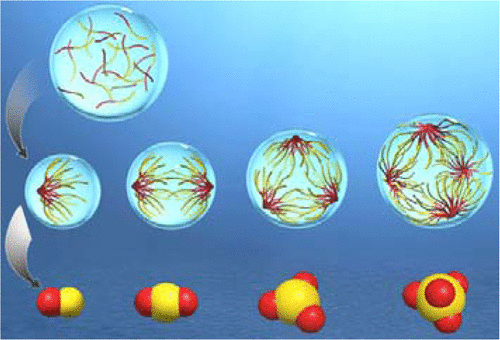
DOI: 10.1021/acs.macromol.5b01261
https://pubs.acs.org/doi/abs/10.1021/acs.macromol.5b01261
17. Lv, Yang; Li, Ailing; Zhou, Fang*; Pan, Xiaoyu; Liang, Fuxin; Qu, Xiaozhong; Qiu, Dong*; Yang, Zhenzhong*. A Novel Composite PMMA-Based Bone Cement with Reduced Potential for Thermal Necrosis, ACS Appl. Mater. Interfaces, 2015, 7(21): 11280-11285.
Percutaneous vertebroplasty (VP) and balloon kyphoplasty (BKP) are now widely used to treat patients who suffer painful vertebral compression fractures. In each of these treatments, a bone cement paste is injected into the fractured vertebral body/bodies, and the cement of choice is a poly(methyl methacrylate) (PMMA) bone cement. One drawback of this cement is the very high exothermic temperature, which, it has been suggested, causes thermal necrosis of surrounding tissue. In the present work, we prepared novel composite PMMA bone cement where microcapsules containing a phase change material (paraffin) (PCMc) were mixed with the powder of the cement. A PCM absorbs generated heat and, as such, its presence in the cement may lead to reduction in thermal necrosis. We determined a number of properties of the composite cement. Compared to the values for a control cement (a commercially available PMMA cement used in VP and BKP), each composite cement was found to have significantly lower maximum exothermic temperature, increased setting time, significantly lower compressive strength, significantly lower compressive modulus, comparable biocompatibility, and significantly smaller thermal necrosis zone. Composite cement containing 20 % PCMc may be suitable for use in VP and BKP and thus deserves further evaluation.

DOI: 10.1021/acsami.5b01447
https://doi.org/10.1021/acsami.5b01447
18. Zhou, Peng; Liang, Fuxin; Liu, Yijiang; Deng, Renhua; Yang, Haili; Wang, Qian; Qu, Xiaozhong; Yang, Zhenzhong*. Janus Colloidal Copolymers, Sci. China Mater., 2015, 58: 961-968.
We propose a new type of nanocomposite that we call Janus colloidal copolymers (JCCPs). JCCPs have two different polymers conjugated on opposite sides of a nanosized colloid. Janus clusters of copolymer PS-b-PAA (where PS is polystyrene and PAA is poly(acrylic acid)) are self-organized within confined mesoporous silica channels onto the surface of iron oxide (Fe3O4) core particles by coordination-induced adsorption. PScPAA diblock JCCPs are fabricated by selective crosslinking of the nanosized PAA domains. In addition, the crosslinked PAA domains are terminated with amine-capped polyethylene glycol (PEG) to form PS-cPAA-PEG triblock JCCPs. The cPAA domain containing functional groups can serve as a nanoreactor to allow in situ preparation of functional materials. The composite JCCPs combine the functionality of nanosized colloids with the amphiphilic performance and self-organization capability of copolymers.
DOI: 10.1007/s40843-015-0103-9
https://link.springer.com/article/10.1007/s40843-015-0103-9